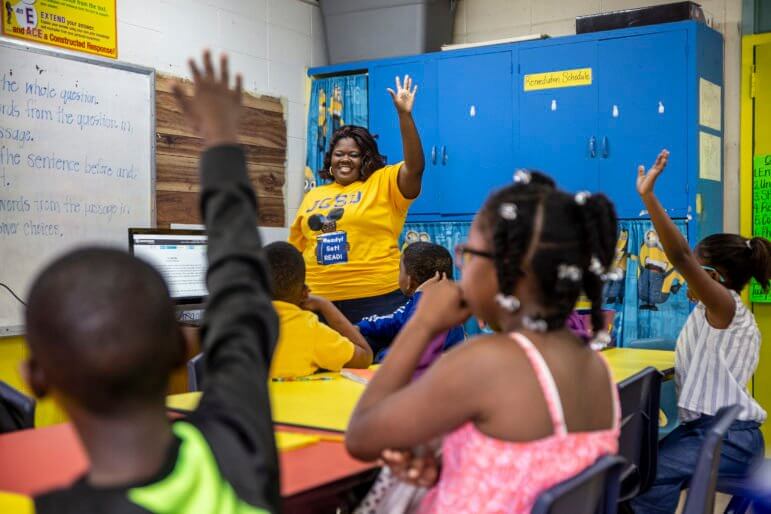

Eric J. Shelton, Mississippi Today/Report For America
Jefferson County third grade teacher Yashica Suddeth is working with students this summer to help them pass a reading test.
Most teacher education preparation programs, including those in Mississippi, are overwhelmingly white. This exacerbates an existing teacher diversity gap which means many teachers do not look like the students they serve, a new study found.
On Tuesday, TNTP, formerly The New Teacher Project, published “A Broken Pipeline Teacher Preparation’s Diversity Problem.” The study used 2017-2018 data from the U.S Department of Education, the most recent available, to analyze the racial divide in teacher preparation programs.
Out of 50 states and Washington, D.C., Mississippi ranks second for the largest diversity gap. Mississippi is one of three states, including Washington, D.C., and Louisiana, that have a teacher prep diversity gap of 30 or more percentage points, according to the report. This gap represents the percentage difference of white students in public schools in comparison to white students enrolled in preparation programs.
In Mississippi during the 2017-28 school year, 76% of those enrolled in teacher preparation programs were white. But only 44% of the public school student population was white.
Nationwide, the majority of 400,000 prospective teachers enrolled in 25,000 teacher preparation programs were white, the study found. When broken down by type of program, alternate route programs (for candidates pursuing a teaching license who have non-education degrees) were 47% more diverse than traditional programs, which were 70% white.
“Our national reckoning with racial injustice has sparked long-overdue conversations about how our education and other systems have historically failed people of color, along with urgent calls to improve them,” the report said. “Closing the teacher diversity gap is one of the most important steps we could take to make public education more equitable.”
The call to diversify the teacher candidate pool speaks to recent research showing the academic, social and emotional benefits for students of color.
But increasing teacher diversity is a complicated issue. Teacher candidates of color — traditionally underserved, with limited advance courses during K-12 education — struggle the most in becoming certified.
A 2019 report by the National Council on Teacher Quality showed programs don’t always prepare teacher candidates to pass the Praxis —four to five certification exams — or require them to take the classes they need in order to teach the necessary content in the classroom.
“It’s a complex problem with many causes, from certification rules that prioritize test scores over teaching ability, to latent bias in district recruitment and hiring processes, to school cultures that too often fail to help teachers of color build long careers in the classroom,” the TNTP report stated.
Mississippi’s public school teacher workforce is primarily composed of white women, which also reflects the makeup of enrollment in prep programs. Mississippi teachers are some of the lowest-paid in the country, even with a $1,500 pay increase last year. The average salary for a public school teacher in 2019 was $45,105, according to the Mississippi Department of Education, and Mississippi’s average salary is the lowest in the nation, according to the National Center for Education Statistics.
READ MORE: Who’s teaching Mississippi’s children? A deep dive into race, gender of state’s educators.
While the authors of the TNTP report don’t solely blame teacher preparation programs for creating or solving this issue, they create the teacher candidate pool, so those programs should make diversity a top priority, the report said.
“State governments, school districts, and even individual schools all have important roles to play in bringing more teachers of color into the classroom and ensuring they stay,” the report stated. “But too often, higher education leaders seek to absolve themselves of responsibility for their programs’ lack of diversity instead of acknowledging their power to change it.”
The TNTP report suggested that educational institutions should recruit more candidates of color, consider financial incentives, create “grow your own” programs, and implement policies to retain teachers of color, among other suggestions.
A February 2019 news release from the Institutions of Higher Learning (IHL) outlined measures taken by public universities to better prepare the “next generation of educators.”
The measures include extensive clinical practice and high quality field experiences to allow candidates to have experience teaching in elementary schools, expanding partnerships with schools, working with digital age learners in traditional and nontraditional settings, along with other professional development opportunities.
The post Mississippi’s teacher prep pool is the second least diverse in the nation appeared first on Mississippi Today.
- Mississippi leaders are quiet on efforts to fix health care in state - December 21, 2025
- Playoff notebook: The legend of Trinidad continues to grow - December 20, 2025
- In a game of firsts, Tulane was a distant second. Rebels advance to face Georgia in Sugar Bowl - December 20, 2025